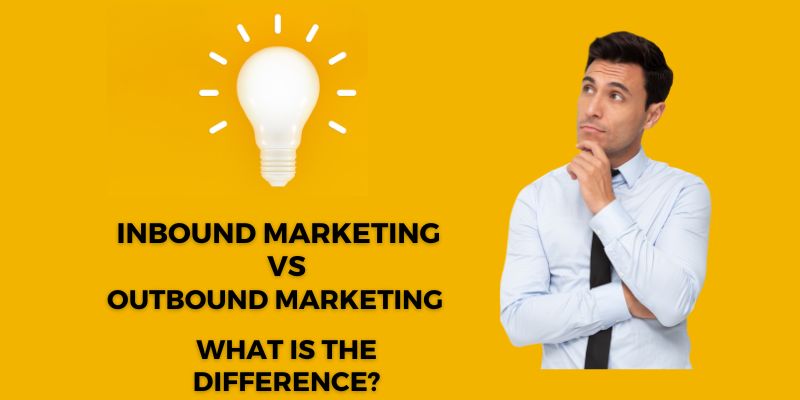Inbound Vs Outbound Marketing: What is the Difference?
We’re going further into inbound vs outbound marketing in this piece. Start scrolling to discover all the distinctions, difficulties, and advantages.
Have you ever been responsible for creating or revising your business’s marketing plan? When talking about prospective project initiatives, one common debate is whether to employ an outbound or inbound marketing approach.
It’s simple to get overloaded with knowledge and suggestions. Is it better to concentrate on creating eye-catching signs, interacting with prospective customers at a trade show, or creating a digital-only plan?
Fortunately, you may narrow your focus with the aid of these two fundamental marketing principles. In this post, we’ll examine the unique uses, advantages, and difficulties of each approach, as well as a summary and examples of their respective applications.
Difference Between Inbound vs Outbound Marketing
The key distinctions between outbound and inbound marketing are numerous. Proactively reaching out to customers to pique their interest in a product is known as outbound marketing. Inbound marketing, on the other hand, focuses on producing and disseminating content that entices visitors to your website.
A more aggressive, all-encompassing strategy is usually used in outbound marketing, with the hope that at least some leads will become conversions. Inbound marketing is typically more understated and concentrates on gradually persuading a certain demographic to make a purchase.
Inbound Marketing
- Informative digital material that is prepared with a specific audience in mind and is intended to assist in problem-solving for users.
- Interactive content may be found in reports, webinars, blogs, social media posts, and other formats.
- Customized messaging is sent to certain recipients.
- A comprehensive approach using several media.
- Measurable with the use of digital marketing tools.
External Marketing
- Non-digital material that is written to promote items and is intended to grab consumers’ attention.
- Content is intended to be passively shown and may be found in direct mail, magazine advertising, billboards, TV, etc.
- In the millions of advertisements that customers encounter every day, messaging needs to stand out.
- Method that is linear and uses few channels.
- Measurement of attribution from physical advertising is challenging.
What is Inbound Marketing?
The main goal of inbound marketing is to draw customers towards your products and services. The top potential customers are looking for products on the internet, as almost two-thirds of shoppers begin their search online.
They start by seeking out goods and services, or information to address a need and resolve an issue. Therefore, your content must detail how your products or services will address their problems, respond to important questions in their specific field, or meet their requirements.
There are numerous methods to accomplish this, such as:
- Online journals or weblogs
- Content in the form of videos
- Books providing information and guidance
- Additional digital marketing material
Each of these pieces of content can also function as a means to distinguish your product from the competition. Include product comparisons, great testimonials, competitive pricing, and excellent reviews in your podcast, social media posts, or reports.
Remember that potential customers need to receive relevant content at different stages during their purchasing process, which should be diverse in material but cohesive in messaging.
An Example of Inbound Marketing
Suppose a client is in search of fresh marketing software. Initially, they might enter “best marketing tool” in a search engine to investigate the field.
The initial organic search result could be a blog post that details the top 10 marketing platforms transparently and impartially. Upon reading the article, they could be interested in furthering their knowledge of digital marketing.
The blog conveniently includes a link at the end to prompt them to register for an upcoming webinar. After clicking the link, they input their name and email to view the content. The website saves their contact details and monitors if they participate in the webinar.
Conveniently, after the blog, there is a link provided to prompt them to register for an upcoming webinar, to gain further insight into a new digital marketing strategy. After clicking the link, they provide their name and email to get the content. The platform saves their contact details and monitors their attendance at the webinar.
After participating in the webinar, they could be curious about whether any companies have effectively put the discussed strategy into practice. Right on schedule, the vendor will send them a follow-up email with case studies demonstrating how a competitor successfully utilized digital marketing to achieve significant ROI.
This causes them to ask for a demonstration from a sales agent. They enter the sales call already intrigued and informed about the software’s functionalities, making it easier for you to make a sale.
Advantages of Inbound Advertising
- If you’re unsure if inbound marketing is the best approach for your business, consider these few advantages:
- It is non-intrusive to use inbound marketing. Potential customers may see your webinars or blog entries at their convenience.
- Content for inbound marketing is instructive. It is made especially for every phase of the sales funnel.
- One can measure inbound marketing. Every component of your plan may be linked to a measure that is tracked over time.
- Because your content and website are updated often, inbound marketing keeps producing leads over time.
Difficulties with Inbound Marketing
Of course, not every business should use inbound marketing. There are several disadvantages to concentrating just on digital material.
Incoming Marketing
- Needs ongoing care and attention. This is to guarantee that content always responds to the changing demands and desires of customers.
- It requires a lot of time and work. It takes time to create and test various content that will persuade users to convert.
- Requires a comprehensive approach. Purchasing tools is necessary to assist you in putting integrated, cross-channel campaigns into action.
Outbound Marketing: What is It?
To close a deal, outbound marketing targets a sizable audience with a message. This tactic is based on the idea that your message will be more effective the larger the group you message.
Traditional marketing is frequently linked to outbound marketing, such as:
- By mail
- Things that Happen
- Signs
- Making cold calls
- Newspapers
- Sound system
- T.V.
Outbound marketing, however, may also be used with more contemporary technologies, such as spam emails and pay-per-click advertising.
Often, those who are being promoted for a product are not even aware of it or are not seeking it. Advertisements promoting the virtues of a particular product may interrupt potential customers while they are browsing a website or watching TV.
An Example of Direct Marketing
A sign advertising a nearby furniture business is seen by a patron who is traveling down the highway. For a moment, they might consider buying a new couch, but they put that thought out of their minds.
A few weeks later, they notice an advertisement for the same furniture company while watching the local news. Once more, they consider purchasing a couch, but they eventually give up as the news resumes.
After three months, they discover a furniture store discount voucher in their mailbox. It so happens that they recently got a bonus at work. They ultimately choose to get that new couch.
The advertisements didn’t mention couches, and they weren’t in a rush to get one. However, advertisements continued to appear in their daily lives, causing them to eventually focus on a need that had not previously been a priority.
Advantages of Direct Marketing
There are certain benefits to outbound marketing that should not be disregarded.
Outbound Marketing
- Increases awareness of the brand. Reach out to those who are unfamiliar with your offerings.
- Can provide outcomes right away. Customers who are interested in your goods and services will likely click on your advertisements and make a purchase.
- Something that customers are accustomed to. They may place more credence in the advertisements they see on TV or in the Sunday paper than
The Difficulties of Direct Marketing
It might be challenging to do outbound marketing correctly. The following are some drawbacks of taking this path:
- Outbound marketing covers a wider range. Making outbound marketing relevant and engaging to all audiences is challenging.
- Customers can easily ignore outbound marketing. Many individuals instantly toss or discard their junk mail, or they mute the TV during advertising.
- It’s more difficult to measure efficacy. Results from some outbound marketing techniques, like billboards, are difficult to quantify.
- Direct marketing is expensive. Attending trade exhibitions, buying billboard spots, and paying for banner marketing all add up.
Sending a message at scale is the main goal of outbound marketing, whereas inbound marketing takes a far more focused approach.
Although there is a good chance that some of the leads you generate with outbound marketing will become customers, this usually comes at a high cost of acquisition.
With inbound marketing, you may craft content specifically targeted at your most qualified leads, as opposed to blasting your product’s name from the rooftops and hoping for a few to take notice.
FAQs
What does outbound marketing signify?
Outbound marketing involves promoting products or services to the public using non-targeted content. It encompasses conventional techniques in marketing and advertising such as:
- Advertising through postal mail
- Electronic Mail
- Advertisements on the radio
- Telephone marketing
Outbound marketing also depends on distributing messages and materials in large quantities, aiming to connect with a wide audience.
What does inbound marketing signify?
Inbound marketing aims to attract customers to your brand through personalized content and experiences. One illustration could involve producing articles or making videos that address important search queries from the target audience.
Inbound marketing frequently generates higher-quality leads and long-lasting relationships by attracting the appropriate audience to your products or services.
Does SEO qualify as Inbound Marketing?
Indeed, SEO is a prime illustration of inbound marketing. It uses search traffic to develop content that is customized for a specific audience. By doing this, your brand can attract individuals who are inclined to purchase items or complete other actions.
Conclusion
Regardless of your marketing plan, it is essential to have a means of navigating the ever-evolving marketing environment. Marketo Engage focuses on:
- Marketing to consumers
- Marketing through mobile devices
- Sending promotional messages through email
- Marketing that focuses on specific target accounts rather than a broader audience.
- Income assignment
- Management of leads
Marketo Engage has assisted numerous large clients in reaching their inbound and outbound marketing objectives by offering fresh ways to connect with customers on a large scale.
You can also read our related articles:










